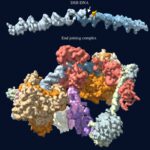Link to Pubmed [PMID] – 8587114
Link to HAL – Click here
Link to DOI – 10.1007/BF00173148
J Mol Evol. 1995 Dec;41(6):703-11.
We describe, on the molecular level, a possible fuzzy and primordial translation apparatus capable of synthesizing polypeptides from nucleic acids in a world containing a mixture of coevolving molecules of RNA and proteins already arranged in metabolic cycles (including cofactors). Close attention is paid to template-free systems because they are believed to be the immediate ancestors of this primordial translation apparatus. The two classes of aminoacyl-tRNA synthetases (aaRSs), as seen today, are considered as the remnants of such a simple imprecise translation apparatus and are used as guidelines for the construction of the model. Earlier theoretical work by Bedian on a related system is invoked to show how specificity and stability could have been achieved automatically and rather quickly, starting from such an imprecise system, i.e., how the encoded synthesis of proteins could have appeared. Because of the binary nature of the underlying proto-code, the first genetically encoded proteins would then have been alternating copolymers with a high degree of degeneracy, but not random. Indeed, a clear signal for alternating hydrophobic and hydrophilic residues in present-day protein sequences can be detected. Later evolution of the genetic code would have proceeded along lines already discussed by Crick. However, in the initial stages, the translation apparatus proposed here is in fact very similar to the one postulated by Woese, only here it is given a molecular framework. This hypothesis departs from the paradigm of the RNA world in that it supposes that the origin of the genetic code occurred after the apparition of some functional (statistical) proteins first. Implications for protein design are also discussed.

